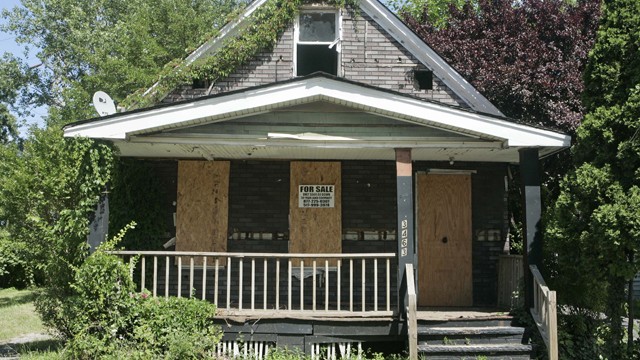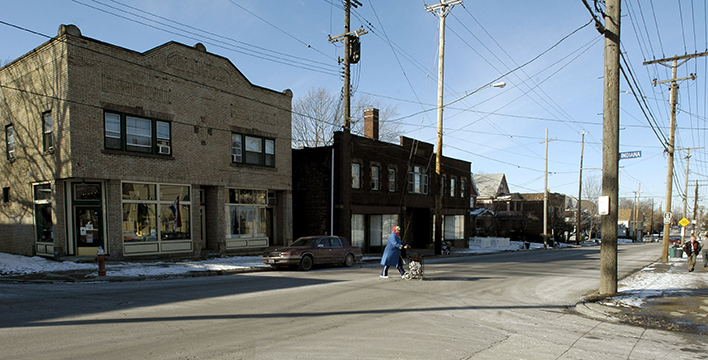The wave of foreclosures that swept the country during the housing crisis may finally be ebbing. Nationwide, the foreclosure rate is at its lowest level since July 2007. But the communities hit hardest are only just beginning to pick up the pieces.
Back in 2008, when America was starting to wake up to the fact that something had gone very wrong in our financial system, Bill Moyers Journal producer Peter Meryash and correspondent Rick Karr went to Cleveland to investigate the growing housing crisis. They visited Slavic Village, a community that they called “ground zero,” where over 1,000 foreclosed homes stood vacant and decaying — the casualties of predatory, subprime mortgages. Watch their report:
In the run-up to the crisis, many retired Slavic Village residents were living on fixed incomes. They already had a mortgage on their home, or had already paid one off. But they needed money for upkeep. So, to make repairs, they remortgaged — but the mortgages they took out were not the kind they were familiar with. These were a new, subprime, predatory breed, the likes of which spread across America like kudzu in the early and mid-2000s.
“I’ve sat in on probably 100 counseling sessions, people facing foreclosure,” then Cuyahoga County treasurer Jim Rokakis told Karr. “I’d say the majority of people fit the criteria of not having enough income, didn’t come in with a down payment, had a bad credit score. [And] most of them got cash back at the close. How’s that for an incentive?”

Slavic Village today
Since 2006, roughly 30 percent of all residential mortgages in Slavic Village ended up in foreclosure, according to figures from the Center on Urban Poverty and Community Development at Case Western Reserve University.* By the time America was calling this wave of foreclosures a crisis, the tide in Cleveland was already beginning to recede.
“We learned a lot. And because we were first, we learned first,” said Barbara Anderson, a longtime resident. “There was nothing like it happening anywhere else for a moment. So we came together to figure out how did this happen and where do we go from here? ‘We can’t stay and wallow in this mess, we gotta get up and get busy.’”
A local bank, Third Federal, invested in redeveloping some neighborhoods. Residents opened art galleries, planted community gardens and converted an old railway to a two-mile bike path, hoping to attract new, younger residents. Anderson said these efforts seem to be paying off.
But the most important thing they learned was to get the vacant buildings — many of which had been gutted by thieves — demolished. “It’s a good thing,” said Anderson. “It leaves room for growth.” The lots were put to public use as parks or gardens, or incorporated into a neighbor’s property.
Anderson repurposed some of the vacant buildings herself after they were donated by banks to a community group she heads, Another Chance of Ohio (ACOO). In one, she operates a freecycle “store” that makes donated furniture, clothing and appliances available to those in need. In another building, donated by CitiMortgage, ACOO operates a shelter for homeless veterans near a local VA hospital, and in another, donated by Wells Fargo, a home for victims of domestic violence.
“That comes from Slavic Village’s philosophy… it’s a tight-knit community. When people fall short, it’s nice to be able to assist.”
Renters catch a small break
In the 2008 report, renters in Cleveland turned out to be some of the hardest-hit victims of the growing crisis. As the crisis played out, renters made up roughly 40 percent of those affected. Many continued to dutifully pay rent, unaware that their landlords had defaulted on their mortgage and that their building was in foreclosure. When the property was seized, tenants lost their security deposits and were given only days to get their belongings together and find somewhere else to live.
That situation has improved somewhat, said Cleveland Tenants Organization Executive Director Angela Shuckahosee, thanks to the Protecting Tenants at Foreclosure Act of 2009, which was later incorporated into Dodd-Frank. The law requires banks to give tenants 90 days notice before eviction — and Shuckahosee said that in Cleveland, banks have done a fairly good job of sticking to that.
But even with the extra time, foreclosure continues to be a major problem for tenants, and Shuckahosee said it is one of the top issues her organization deals with. “We get a lot of calls from folks who either didn’t get the notice or might not understand the notification,” she said.
The Protecting Tenants at Foreclosure Act of 2009 is set to expire at the end of this year. Senator Sherrod Brown (D-OH) has called for it to be extended indefinitely, but his bill and a similar measure in the House have yet to attract a single Republican co-sponsor.
Making room for renewal
Jim Rokakis, the former Cuyahoga County treasurer, has made a job out of “burying the bodies” of the war he says his city lost. “Vacant properties are a cancer, and they drag everything down around them,” he said. A seminal study conducted by Detroit, and others since, found that the faster a city can demolish a blighted building, the better it can prevent that blight from spreading through the neighborhood.
Rokakis is a vice president at the Western Reserve Land Conservancy, where he has sought to establish land banks in all of Ohio’s major cities. A land bank, a quasi-public corporation comprised of city officials and real estate financiers, can foreclose on tax-delinquent vacant properties and take control of them without a public bidding process. The land bank can then demolish them and clear the way for something new to take their place. Twenty-two of the 42 Ohio counties with a large enough population for a land bank now have them.
As in Slavic Village, plots can be incorporated into a neighbor’s yard, become parks or community gardens, or even make room for reforestation. Starting this fall, through a grant from the Great Lakes Restoration Initiative, Cleveland plans to plant 1,000 trees in five neighborhoods.
In the wake of the crisis
Though the worst is over, Cleveland is still struggling. The unemployment rate remains high, peaking, for the last twelve months, at 8.7 percent in January (though down from 10 percent in 2010). Angela Shuckahosee of the Cleveland Tenants Organization says the depressed economy continues to create housing troubles in Cleveland, even as the rest of the country gradually recovers.
“Folks simply are using too much of their income for housing,” said Shuckahosee. “[If] you have one life event — maybe it’s a car wreck, or maybe you lose your job, or maybe you have to pay for a funeral — you’re in a downward spiral, and that’s why foreclosures are still happening.”
Community activist Barbara Anderson believes the greed that motivated the mortgage lenders will never really go away. “It will come back as a redesigned animal. We can see it right now in payday lending, car title loans, in some aspects of reverse mortgages. We can see it in student loans and student debts.
“The hope is that those of us who have a watchful eye will sound the bell louder next time. We thought we did, but so many people just didn’t believe.”
* Special thanks to Michael Schramm at the Cuyahoga Land Bank for help hunting down and understanding these figures.



